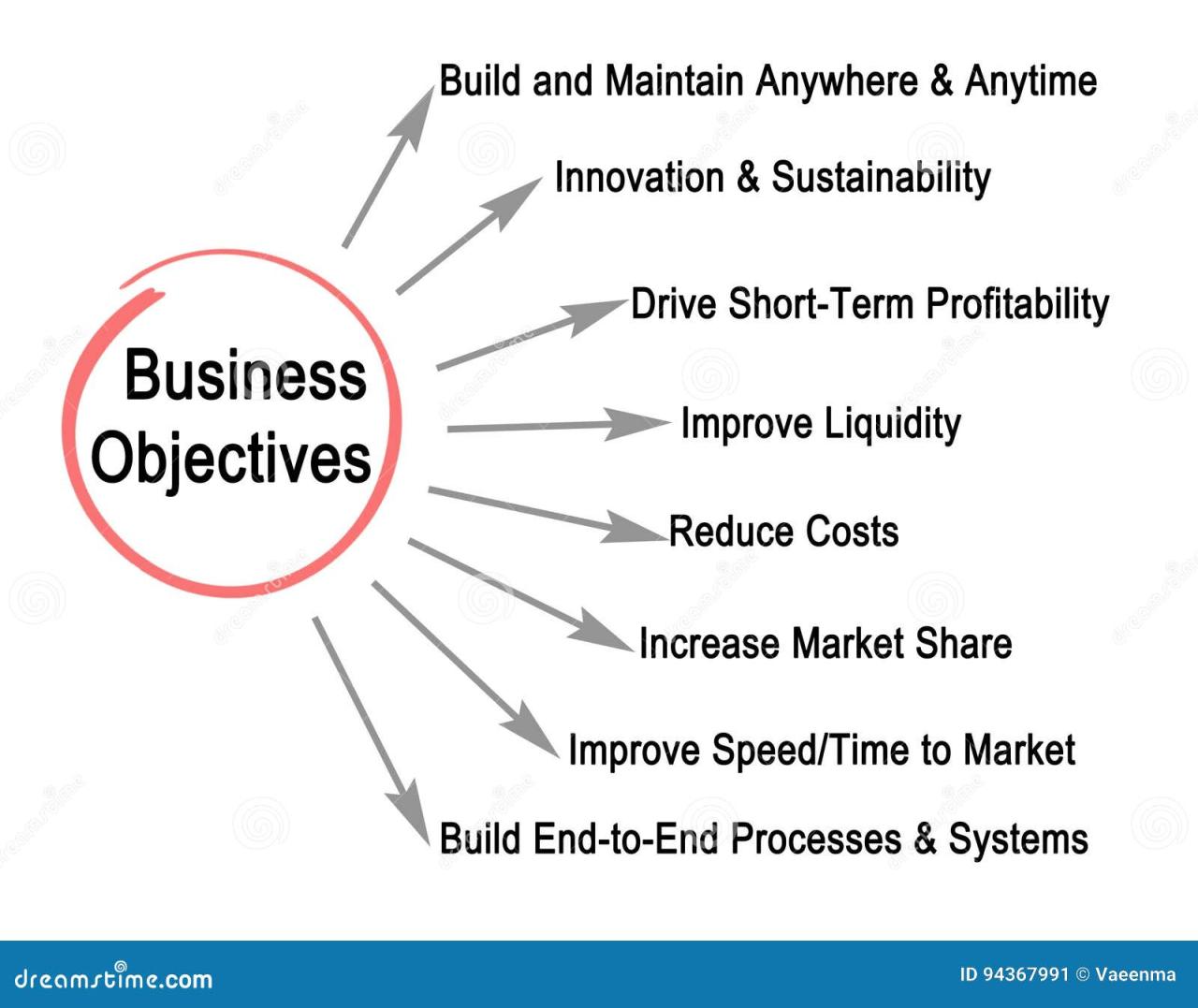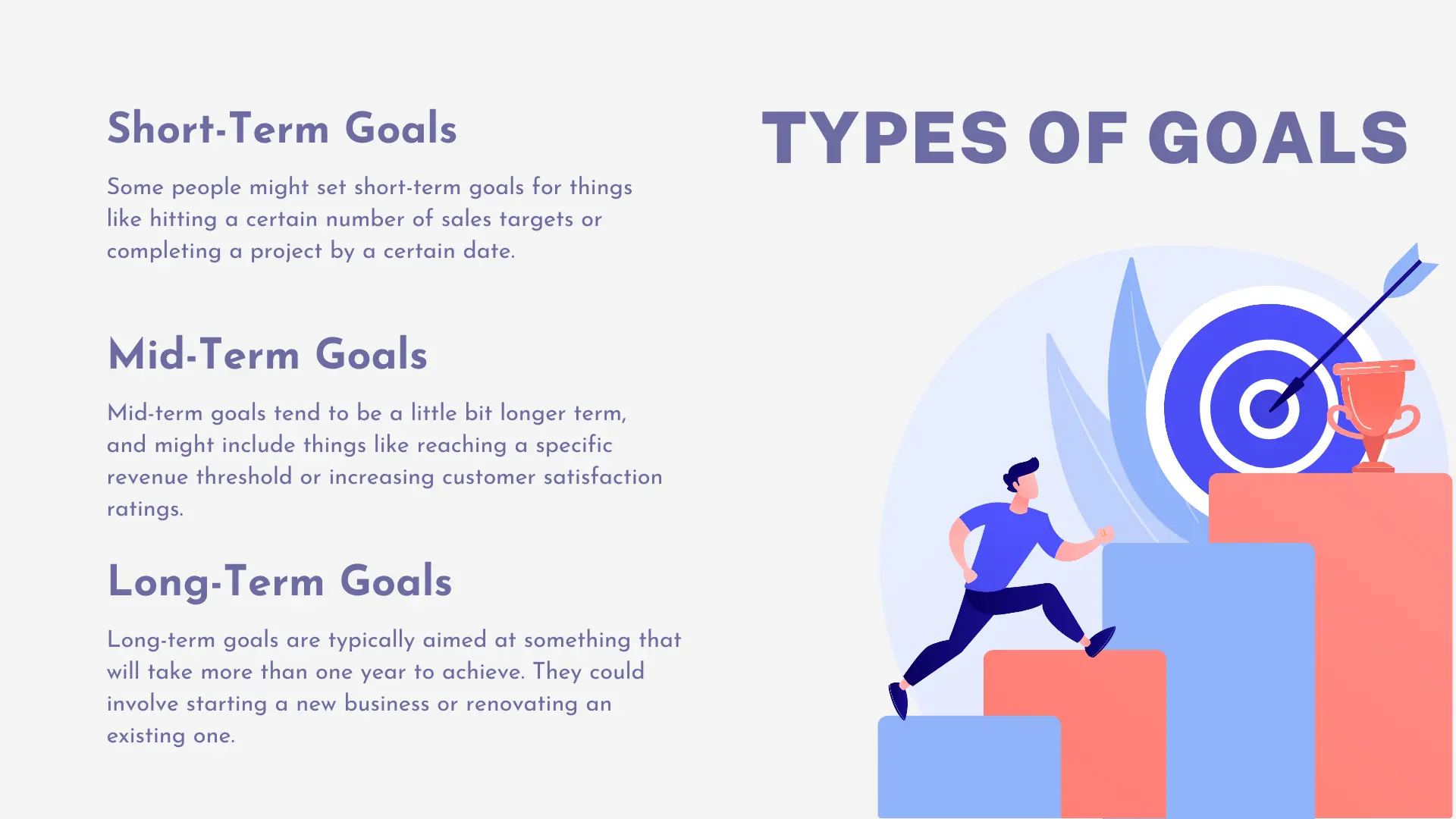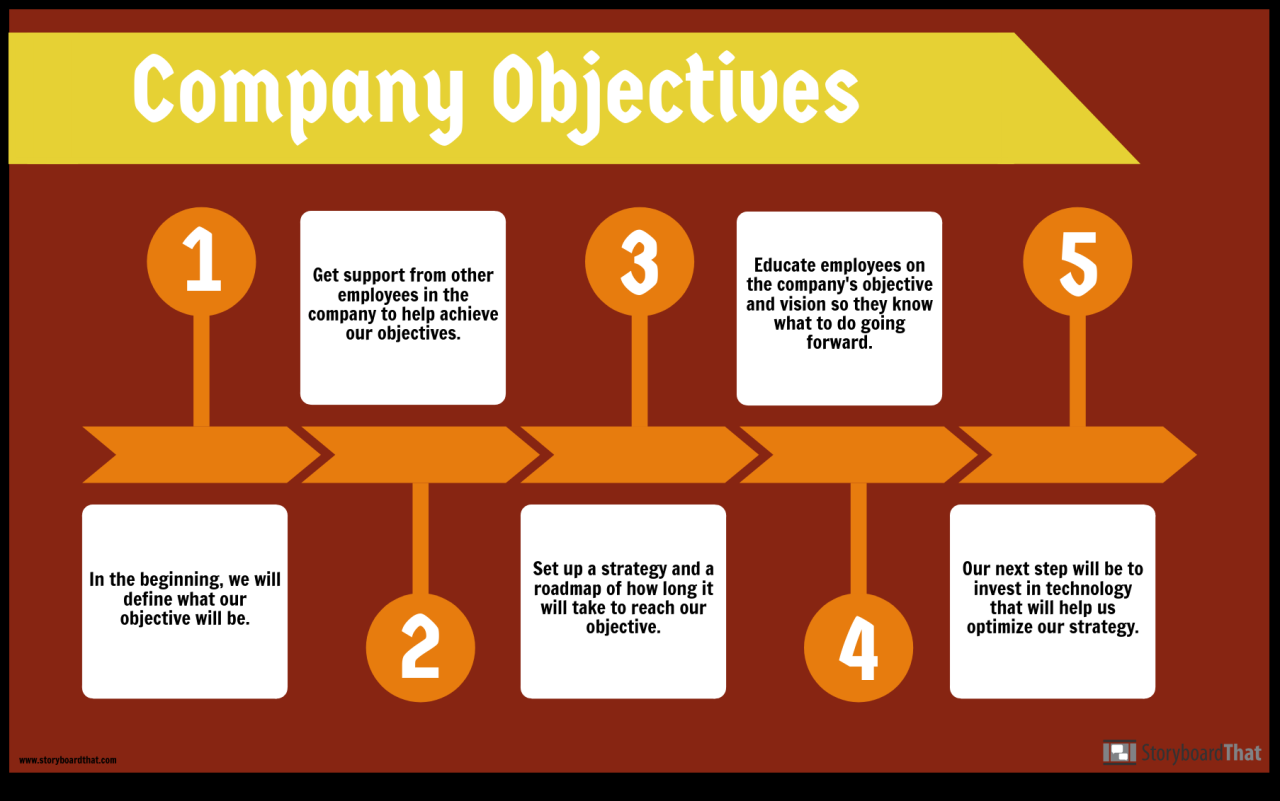Long-term business goals represent the compass guiding a company towards sustained success. This exploration delves into the multifaceted process of defining, planning, and achieving these ambitious targets, from crafting a measurable framework to allocating resources effectively and communicating a compelling vision to stakeholders. We will examine successful strategies employed by industry leaders and discuss crucial aspects like risk management and adapting to dynamic market conditions.
Understanding and implementing a robust long-term strategy is not merely about setting targets; it’s about creating a clear path, fostering internal alignment, and securing the company’s future. This involves a deep dive into strategic planning, resource allocation, progress monitoring, and consistent communication. The journey towards achieving long-term business goals demands meticulous planning, adaptable strategies, and a clear vision shared by all stakeholders.
Defining Long-Term Business Goals

Long-term business goals represent the aspirational milestones a company aims to achieve over an extended period, typically three to five years or more. These goals provide a strategic roadmap, guiding decision-making and resource allocation towards a desired future state. Unlike short-term objectives, which focus on immediate accomplishments, long-term goals encompass broader, more transformative changes within the organization.
Defining long-term goals requires careful consideration of the company’s overall vision and mission. Aligning these goals ensures that all efforts are directed towards a unified purpose, maximizing efficiency and minimizing the risk of conflicting priorities. Without this alignment, the company might pursue various initiatives that ultimately detract from its core purpose, leading to wasted resources and missed opportunities.
The Importance of Alignment with Vision and Mission
Aligning long-term goals with the company’s vision and mission is paramount for sustained success. The vision statement articulates the desired future state of the company, while the mission statement Artikels its purpose and how it intends to achieve its vision. Long-term goals should directly contribute to the realization of both the vision and mission. For example, a company with a vision of becoming a global leader in sustainable technology might set long-term goals focused on expanding into new international markets, developing innovative green technologies, and achieving carbon neutrality. These goals are directly linked to the company’s overall vision and mission, ensuring that all efforts are focused and coordinated.
Establishing Measurable and Achievable Long-Term Goals Using SMART Criteria
The SMART criteria provide a robust framework for defining effective long-term goals. Each goal should be Specific, Measurable, Achievable, Relevant, and Time-bound. Specificity eliminates ambiguity, ensuring everyone understands the goal’s objective. Measurability allows for progress tracking and accountability. Achievability ensures the goal is realistic and attainable given the company’s resources and capabilities. Relevance confirms the goal aligns with the overall vision and mission. Finally, a Time-bound aspect provides a deadline, fostering a sense of urgency and facilitating progress monitoring. Without the SMART framework, goals remain vague aspirations, lacking the structure necessary for effective execution.
Example of Long-Term Goal Structure
The following table demonstrates how to structure long-term goals using the SMART criteria.
| Goal | Metric | Target | Timeline | Responsible Party |
|---|---|---|---|---|
| Increase market share in the North American region | Percentage of market share | 15% increase from current 10% | 3 years | Sales & Marketing Department |
| Expand product line to include three new sustainable products | Number of new products launched | 3 new products launched | 2 years | Product Development Team |
| Reduce carbon footprint by 20% | Tons of CO2 emissions reduced | 20% reduction in CO2 emissions | 5 years | Sustainability Committee |
| Improve customer satisfaction rating by 10 points | Customer Satisfaction Score (CSS) | Increase CSS from 75 to 85 | 1 year | Customer Service Department |
Strategic Planning for Long-Term Goals

Developing a robust strategic plan is crucial for translating long-term business goals into tangible results. It provides a roadmap, guiding decision-making and resource allocation to ensure consistent progress towards desired outcomes. Without a well-defined strategy, even the most ambitious goals risk becoming unattainable. This section will explore key aspects of strategic planning, drawing on examples from successful businesses and outlining a practical step-by-step process.
Examples of Successful Long-Term Business Strategies
Several industry leaders have demonstrated the power of effective long-term strategic planning. For instance, Amazon’s relentless focus on customer experience and technological innovation, coupled with a commitment to long-term growth over short-term profits, has propelled its dominance in e-commerce. Similarly, Apple’s consistent emphasis on design, user-friendliness, and a tightly controlled ecosystem has created a highly loyal customer base and sustained market leadership. These strategies weren’t developed overnight; they are the result of careful planning, adaptation, and consistent execution over many years. Another example is the diversification strategy employed by Berkshire Hathaway, which, through strategic acquisitions, has built a vast and resilient portfolio across various industries, mitigating risk and fostering long-term growth.
Conducting a SWOT Analysis
A SWOT analysis is a fundamental tool in strategic planning. It involves identifying the company’s internal Strengths and Weaknesses, and external Opportunities and Threats. Strengths might include a strong brand reputation, a skilled workforce, or proprietary technology. Weaknesses could be outdated infrastructure, inefficient processes, or a lack of expertise in a key area. Opportunities could be emerging markets, technological advancements, or changes in consumer preferences. Threats might include increasing competition, economic downturns, or regulatory changes. By systematically analyzing these factors, businesses can identify areas for improvement, capitalize on opportunities, and mitigate potential risks, aligning their strategies with the realities of the market landscape. For example, a company considering market expansion might identify a strong brand (strength) and an underserved market (opportunity) while recognizing potential regulatory hurdles (threat) and a lack of local market knowledge (weakness).
Step-by-Step Strategic Plan for Market Expansion
A strategic plan provides a clear path towards achieving a long-term goal. Let’s Artikel the steps involved in a market expansion strategy. This structured approach ensures that resources are allocated effectively and progress is monitored consistently.
- Market Research and Analysis: Thoroughly investigate the target market, including demographics, competition, and consumer behavior. This phase might involve surveys, focus groups, and competitor analysis.
- Develop a Market Entry Strategy: Choose the appropriate approach, such as direct investment, joint ventures, franchising, or exporting, based on the resources available and the market characteristics.
- Resource Allocation: Determine the financial, human, and technological resources required for the expansion. This might involve securing funding, hiring personnel, and investing in new infrastructure.
- Develop a Marketing and Sales Plan: Create a comprehensive marketing strategy to reach the target audience and build brand awareness in the new market. This plan will include branding, advertising, and distribution strategies.
- Implementation and Monitoring: Execute the plan and monitor progress closely. This involves tracking key performance indicators (KPIs) and making adjustments as needed. Regular review and adaptation are crucial for success.
- Evaluation and Adaptation: Regularly assess the effectiveness of the expansion strategy and make necessary adjustments based on performance data and market feedback. This iterative process is essential for optimizing results and ensuring long-term success.
Resource Allocation and Investment
Effective resource allocation is crucial for translating long-term business goals into tangible achievements. A well-defined plan ensures that the right resources are directed towards the most promising initiatives, maximizing return on investment and minimizing risk. This section details the process of identifying, allocating, and justifying investments in support of long-term strategic objectives.
Resource allocation necessitates a clear understanding of the resources required and a structured approach to their deployment. This involves careful consideration of financial capital, human talent, and technological infrastructure. Effective allocation maximizes the probability of success for each goal by aligning resources with priorities and minimizing redundancy or wasted effort.
Key Resource Identification
Achieving long-term business goals demands a thorough assessment of necessary resources. Financial resources encompass capital expenditure for new equipment, research and development, marketing campaigns, and operational expenses. Human resources include skilled personnel, management expertise, and effective team structures. Technological resources involve software, hardware, data analytics capabilities, and digital infrastructure. For example, a company aiming for market expansion might require significant investment in marketing and sales teams (human resources), new distribution channels (financial resources), and a robust customer relationship management (CRM) system (technological resources).
Resource Allocation Plan, Long-term business goals
A strategic resource allocation plan prioritizes goals based on their potential return and aligns resources accordingly. This involves developing a detailed budget, assigning responsibilities, and establishing clear timelines. A phased approach, allocating resources incrementally as milestones are achieved, mitigates risk and allows for course correction. For instance, a company launching a new product might initially invest heavily in research and development, then shift focus to marketing and sales as the product nears launch. Regular monitoring and adjustments are vital to ensure the plan remains aligned with evolving circumstances and performance data.
Justification of Investment Decisions
Justifying investment decisions to stakeholders requires a compelling narrative that demonstrates the value proposition of each initiative. This involves presenting a clear articulation of the long-term goals, the anticipated return on investment (ROI), and the potential risks involved. Financial models, market analysis, and competitive benchmarking can be used to support the justification. For example, a proposed investment in a new technology might be justified by demonstrating its potential to increase efficiency, reduce costs, or enhance the customer experience, leading to increased revenue and profitability. Transparency and clear communication are crucial to build trust and secure stakeholder support.
Resource Allocation Visualization
A visual representation of resource allocation can be created using a matrix. The rows represent the different long-term goals (e.g., market expansion, product development, operational efficiency). The columns represent the key resource categories (financial, human, technological). Each cell in the matrix displays the allocated amount of each resource type for each goal. This matrix provides a clear overview of resource distribution, allowing for easy identification of potential imbalances or areas requiring further attention. For instance, a larger allocation in the “financial” column for the “market expansion” goal would visually represent a significant investment in marketing and sales efforts for that particular objective. Color-coding could further enhance the visual impact, with darker shades representing larger resource allocations. This allows stakeholders to quickly grasp the overall resource allocation strategy and identify any potential bottlenecks or areas of over- or under-investment.
Monitoring Progress and Adapting Strategies
Successfully achieving long-term business goals requires a robust system for tracking progress and adapting strategies as needed. This involves establishing clear metrics, regularly reviewing performance, and making informed decisions based on data and market changes. Ignoring this crucial aspect can lead to missed opportunities and ultimately, failure to reach desired outcomes.
Regular monitoring allows for proactive adjustments, preventing minor setbacks from escalating into major problems. By establishing a clear framework for data analysis and strategic adaptation, businesses can significantly increase their chances of long-term success.
Key Performance Indicator (KPI) Selection and Tracking
Choosing the right KPIs is paramount. These metrics should directly reflect progress towards long-term goals and be measurable, achievable, relevant, and time-bound (SMART). For example, a company aiming to increase market share might track website traffic, conversion rates, and brand mentions. A manufacturing company focused on efficiency might monitor production output, defect rates, and machine downtime. Regular data collection, perhaps weekly or monthly, depending on the KPI and business cycle, should be integrated into existing workflows to ensure consistent and reliable data. This data can be tracked using spreadsheets, dedicated project management software, or business intelligence dashboards.
Data Interpretation and Area Identification for Improvement
Interpreting performance data involves comparing actual results against pre-defined targets. Significant deviations warrant investigation. For instance, if website traffic is consistently below projections, a deeper analysis might reveal issues with , marketing campaigns, or website usability. Similarly, if production output falls short, investigation could uncover bottlenecks in the supply chain, equipment malfunctions, or workforce training deficiencies. This process requires a critical evaluation of data trends, identifying patterns and potential causal factors. Root cause analysis techniques can be particularly helpful in pinpointing the underlying reasons for performance gaps.
Strategic Adaptation Based on Performance Data and Market Conditions
Adapting strategies requires a flexible and responsive approach. If performance data reveals significant shortcomings, the initial strategy might need to be revised. This could involve adjusting marketing campaigns, reallocating resources, or even re-evaluating the long-term goals themselves. External factors, such as economic downturns, changes in consumer preferences, or the emergence of new competitors, also necessitate strategic adjustments. For example, a company facing increased competition might need to invest more in R&D to develop innovative products or services, or implement a more aggressive marketing strategy. The ability to adapt quickly and decisively is crucial for maintaining a competitive edge.
Risk Management Approaches
Different approaches exist for managing the inherent risks and uncertainties associated with long-term goals. A proactive approach involves identifying potential risks early on and developing contingency plans to mitigate their impact. This might include scenario planning, which involves developing plans for various potential outcomes, or risk assessment matrices, which help prioritize risks based on their likelihood and potential impact. A reactive approach, on the other hand, involves responding to risks as they arise. While reactive approaches are necessary, a proactive approach is generally more effective in minimizing disruptions and maximizing the chances of success. The choice between these approaches often depends on the nature of the business, the industry, and the specific long-term goals being pursued. A hybrid approach, combining elements of both proactive and reactive strategies, is often the most effective.
Communicating Long-Term Vision: Long-term Business Goals
Effectively communicating a long-term vision is crucial for aligning all stakeholders – employees, customers, and investors – towards a shared future. A clearly articulated and compelling vision fosters commitment, drives action, and ultimately contributes to the success of the long-term business goals. Without effective communication, even the most meticulously planned strategy risks failing to achieve its potential.
Effective communication methods for conveying long-term goals and strategies involve tailoring the message to resonate with each specific audience. This requires understanding their individual needs, concerns, and preferred communication channels. Creating a compelling narrative around the vision, emphasizing the “why” behind the goals, is equally important to inspire buy-in and sustained effort. Companies that successfully communicate their long-term vision often utilize a multi-pronged approach, leveraging various channels and consistently reinforcing the message over time.
Effective Communication Strategies
A robust communication plan should employ diverse methods to reach and engage various stakeholders. These methods should be carefully selected to ensure clarity, impact, and sustained engagement.
| Target Audience | Message | Communication Channel | Example |
|---|---|---|---|
| Employees | Highlight how long-term goals directly impact their roles, responsibilities, and career growth opportunities; emphasize the company’s commitment to employee development and success within the context of the long-term vision. | Town hall meetings, internal newsletters, company intranet, regular team meetings, performance reviews incorporating long-term goals. | A tech company might communicate its goal of becoming a leader in AI by showcasing how individual teams’ projects contribute to that overarching objective, providing training opportunities in AI-related skills, and highlighting career advancement paths within the AI division. |
| Customers | Focus on the value proposition—how the long-term vision translates into improved products, services, and customer experience. Emphasize the company’s commitment to innovation and long-term sustainability. | Website updates, social media campaigns, email marketing, customer surveys, press releases, public relations efforts. | An automobile manufacturer might communicate its commitment to sustainable mobility by highlighting its investments in electric vehicle technology, showcasing fuel-efficient models, and promoting its commitment to reducing carbon emissions through its manufacturing processes. This could be done through targeted social media campaigns and informative website content. |
| Investors | Present a clear and concise articulation of the long-term strategic plan, highlighting key performance indicators (KPIs) and anticipated financial returns. Emphasize the company’s competitive advantage and risk mitigation strategies. | Investor presentations, annual reports, financial news releases, quarterly earnings calls, investor relations website. | A pharmaceutical company might communicate its long-term goal of developing innovative cancer treatments by presenting its research pipeline, clinical trial data, and projected market share to investors, demonstrating a clear path to profitability and positive social impact. |
| Community Stakeholders | Focus on the company’s social responsibility initiatives and how the long-term vision contributes to the well-being of the community. Highlight the company’s commitment to environmental sustainability and ethical business practices. | Community engagement events, local media outreach, corporate social responsibility reports, partnerships with local organizations. | A renewable energy company might communicate its long-term goal of transitioning to a cleaner energy future by showcasing its community investment programs, highlighting its commitment to creating green jobs, and participating in local environmental initiatives. This could involve sponsoring community events and partnering with local environmental organizations. |
Final Thoughts

Successfully navigating the path to long-term business goals requires a blend of strategic foresight, meticulous planning, and consistent adaptation. By defining clear, measurable objectives, allocating resources effectively, and fostering open communication, businesses can build a robust foundation for sustainable growth. The journey may present challenges, but with a proactive approach to monitoring progress and adjusting strategies as needed, organizations can confidently steer their course toward a future of sustained success.
Defining long-term business goals requires a clear vision and strategic planning. Much like crafting a compelling narrative, success hinges on a well-structured approach; understanding the nuances of storytelling, as outlined in this helpful guide on Cara menulis skrip film , can offer valuable insights into building a persuasive business plan. Ultimately, achieving ambitious long-term goals depends on a carefully constructed roadmap, much like a successful film script.
Establishing long-term business goals requires a clear vision and strategic planning. One might consider diversifying into unexpected markets, for example, by exploring the potential of mobile gaming; a successful example could be leveraging the popularity of a fast-paced boat racing game like the one found at Game balap perahu cepat. Ultimately, such ventures contribute to the overall growth and sustainability outlined in a company’s long-term objectives.